
So you have bed bugs? You are not alone. Bed bugs are more common than you think. More often than not, you can get rid of bed bug outbreaks on your own without the help of a professional.
Effective chemical treatments you can easily administer on your own include Temprid FX, Crossfire, and Bedlam Plus. These are highly effective insecticides in the treatment of localized bed bug outbreaks. When infestations are extensive, enlisting the help of a professional for whole-house fumigation, heat treatment, and other treatment methods may be necessary.
Bed bugs are evasive pests that hide in places you would not expect. Getting rid of your bed bugs requires pinpointing these specific areas and treating them appropriately. It is also important to understand the types of treatments that are available, how quickly each treatment works, which can be applied yourself, and which requires a licensed pest management professional.
See also my article: “How To Prepare Your Home For A Bed Bug Treatment.”
This article provides four golden nuggets of useful information:
- What You Should Know About Bed Bugs
- Treatment Comparison Guide,
- Four Step DIY Guide, and
- Recommended DIY Products.
These four nuggets of information (with corresponding visuals) are enough for you to begin tackling your bed bugs. For folks that want more specifics, I’ve got you covered too. I will provide a deeper dive following the introduction of each nugget.
You might also be interested in reading this article: “How To Identify And Get Rid Of Powderpost Beetles“.
What You Should Know About Bed Bugs
A general understanding of bed bugs, their life cycle, and their behaviors is extremely helpful. The visual below provides the foundation for What You Should Know, with a deeper dive that follows.
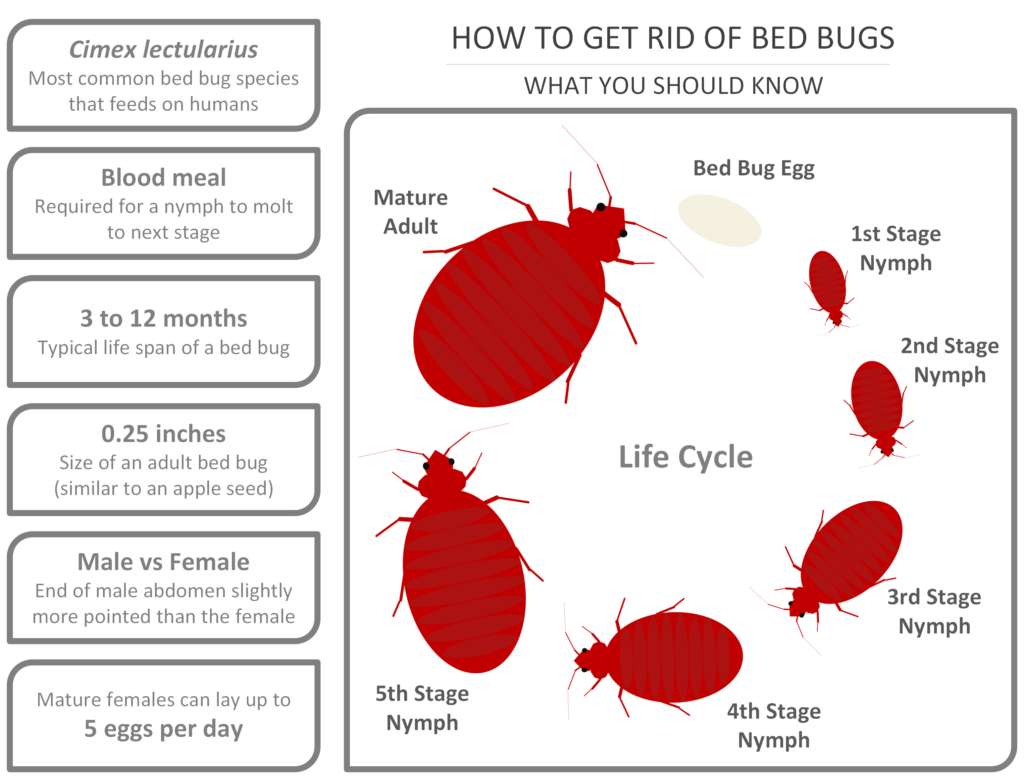
Bed Bug Life Cycle
When a female bed bug is impregnated, she often begins to wander away from her original colony (referred to as female dispersal). Eggs are laid and often form a new colony in a different area. For this reason, it is not uncommon to see small groupings of 30 to 50 bed bugs in various areas of a room.
Once eggs are laid, they take approximately two weeks to hatch. Newly hatched bed bugs (nymphs) will molt five times before becoming mature adults. (Molting is a process of transitioning where the exoskeleton is shed.) When transitioning through each life stage towards adulthood, each stage of transformation requires a blood meal. This is an approximately 5-week process under ideal conditions (e.g., room temperature and availability of a blood meal).
Young nymph bed bugs are translucent before their first blood meal, making them difficult to see with the naked eye. After feeding, they appear rust in color. Adult bed bugs have oval-shaped bodies approximately 0.25” in length (about the side of an apple seed). Their bodies may appear inflated (after feeding) or flat (without a recent blood meal). While bed bugs do have wings, they are not used for flying.
The typical lifespan of a bed bug is three months to 1 year.
When Bed Bugs Bite
Once reaching the adult stage, bed bugs typically feed weekly. However, they can go several months without eating. Most bed bugs feed in the middle of the night, typically between 11 pm – 3 a.m. When bed bugs feed, they bite multiple times before settling on an ideal place to feed. This behavior often results in a bite pattern on people that resembles a line of bites. While it appears as several bites, it is often the result of a single bed bug.
Similar to mosquito bites, a numbing occurs when bed bugs bite. Itching and inflammation can sometimes take up to a week to occur. When inflammation from bed bug bites does occur, it causes other bites to inflame simultaneously. While you may have been bitten over several days, you may experience itching and inflammation at once.
The entire feeding process only takes between 3 to 10 minutes to complete. While feeding, bed bugs will urinate. Their urine is blood-colored and will often appear on bed sheets as blood. After feeding, bed bugs return to their colony, huddling together to retain moisture and warmth until their next feeding.
The most common issues with bed bug bites are irritation and itching, which can lead to secondary skin infections if scratched excessively. For many years, bed bugs were not known to transmit infectious diseases. In recent years, studies have shown that bed bugs may transmit Trypanosoma cruzi, a parasite known for its link to Chagas disease; however, this is considered rare.
Bed Bug Behaviors
A common misconception is that bed bugs only live on or in a mattress. While a bed is typically where bed bugs will feast, it is not necessarily where they reside when not eating. Bed bugs will hide behind anything and everything: behind picture frames, in crevices of furniture, bedframes, baseboards, etc. This is one of the reasons why treatment is difficult. Bed bugs can literally be anywhere within a room or home, reemerging when it is time to eat again.
The body heat and exhalation of CO2 in humans will attract bed bugs. They have been known to travel up to 100 feet for a blood meal, including through walls to adjoining rooms. Bed bugs huddle in small groups to maintain their body temperatures when not feeding.
The Resurgence Of Bed Bugs
Bed bugs have been around for many years. They have coexisted with humans for thousands of years and have even been found in ancient Egyptian tombs. Until the 1940s, bed bugs were commonplace before they were eradicated for many years.
One theory on the eradication of bed bugs was the introduction of DDT. DDT, a synthetic pesticide, was a commonly used pesticide from World War II to the early 1970s until it was banned in the United States due to risks to humans and wildlife. DDT was an extremely effective pesticide (against many insects, including mosquitos), easy to manufacture, and inexpensive. For these reasons, it was widely used. DDT is believed to have wiped out most bed bugs for many years. However, bed bugs that did survive and reproduce gave way to a bed bug species resistant to DDT.
In the 1990s, bed bugs started to reemerge. Pyrethroids were one of the most common pesticides at the time. The prolonged use of pyrethroids, like DDT, ultimately gave rise to pyrethroid-resistant strains of bed bugs and allowed a resurgence. It is believed that the combination of pesticide-resistant bed bug strains and the prevalence of more global travel caused another resurgence around 2010.
When I first started in the pest control industry, cases of bed bugs were rare. Within the industry, there was a slight uptick in cases from 2003-04, and it was widely known that strain was resistant to both DDT and pyrethroid products. I saw a single, isolated case of bed bugs in 2003 and nothing for years. In 2008, things changed significantly, and bed bugs began to reemerge. My case rate of bed bugs exploded from ~5 cases in 2008 to ~250 cases in 2010.
Since the resurgence in 2010, extensive scientific research has been conducted that has resulted in new, innovative treatments for outbreaks. Today, there is no longer a ‘one-size-fits-all’ treatment for bed bugs.
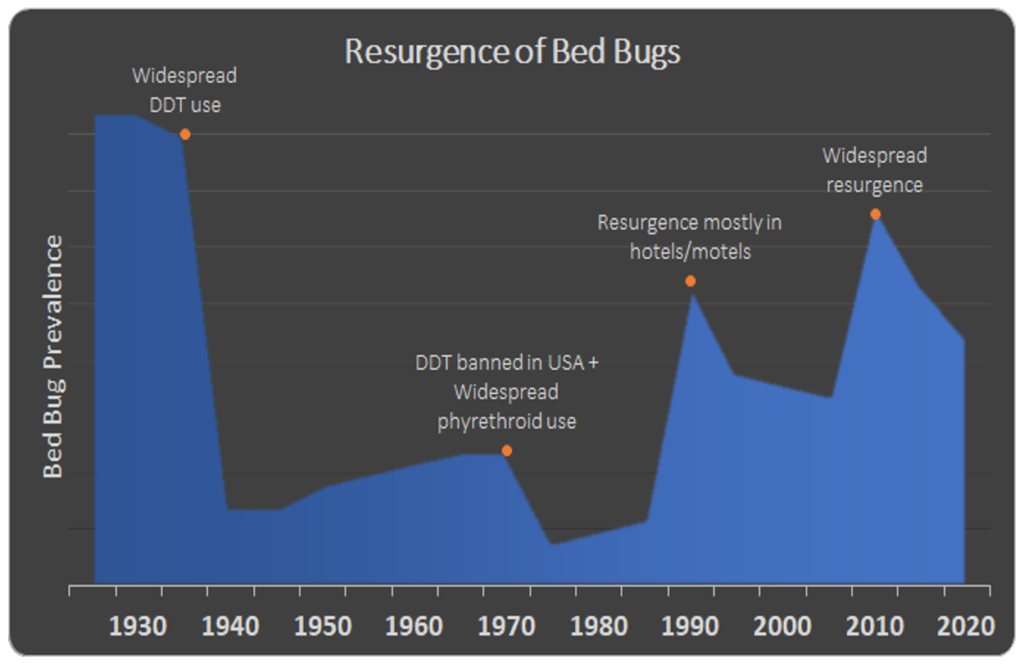
Treatment Comparison
With newer strains of bed bugs resistant to traditional pyrethroid products and DDT (now banned in the United States), there was a challenge in the industry and scientific community to come up with new, effective ways to treat bed bug infestations.
Today, there are five common types of treatments for bed bugs:
- Chemical Insecticides
- Desiccants
- Fumigation
- Fungal Bioinsecticide
- Heat Treatments
A high-level comparison of these different treatment types is provided in the table below. A deep dive into the specifics of each treatment is provided in the sections that follow.
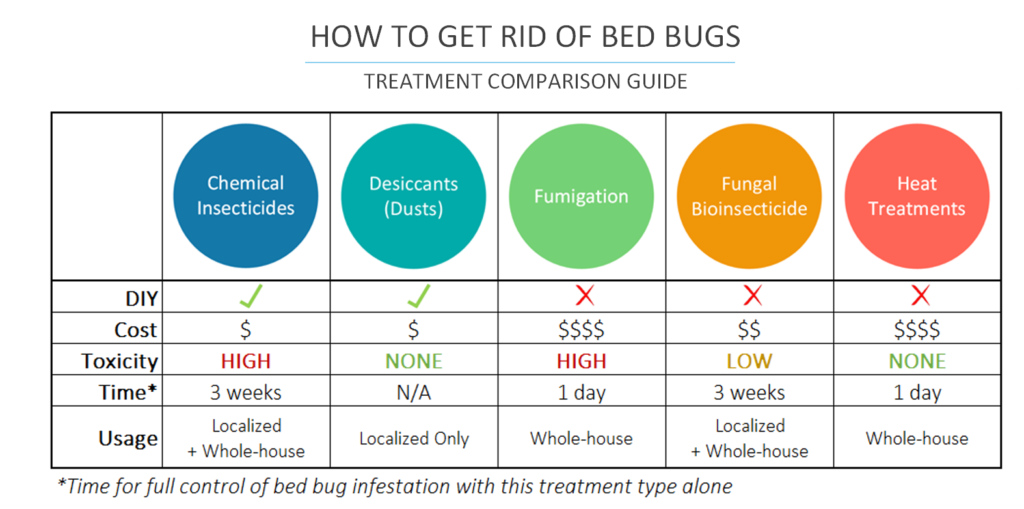
Chemical Insecticides

Pyrethrin is an organic compound found in chrysanthemum flowers, which has been used as a natural insecticide for many years. Pyrethrin-based pesticides cover a broad spectrum of pests, ranging from spiders and cockroaches to termites and bed bugs. Pyrethrin is effective as a pesticide by targeting the nervous system and killing insects that digest it or come into contact with it.
Pyrethroids are man-made chemicals engineered to mimic the effects of pyrethrin in insects. These synthetic, pyrethroid-based pesticides are inexpensive to manufacture and are known to have a longer residual effect than natural, pyrethrin-based pesticides. Most commercial insecticides use a pyrethroid as an active ingredient.
While hundreds of pyrethroids exist, only a handful are used in the United States. Some of the most common pyrethroids in commercially available insecticides include:
- Metofluthrin
- Permethrin
- Resmethrin
- Phenothrin (also called Sumithrin)
Households with pets should be careful in the use of pyrethroids. While it is generally not toxic to mammals, cats are the exception.
Because pyrethroids have been used extensively in the treatment of bed bugs for many years, many bed bug populations have developed a resistance to pyrethroids. Specific chemical additives (synergists) are now being added to pyrethroid-based pesticides to address this. Synergists themselves are not effective pesticides, rather they target insects in a way that allows pyrethroids to be more effective.
Common insecticide synergists include:
- PBO (piperonyl butoxide)
- MGK-264 (n-octyl bicycloheptane dicarboximide)
- EN16/5-1 (6-[2-(2-butoxyethoxy) ethoxymethyl]-5-propyl-2, 3-dihydrobenzofuranby)
- PBH (3-Phenoxybenzyl hexanoate)
- Sesamex (also referred to as sesoxane)
Nicotine (isolated from tobacco plants) has been used as a pesticide for chewing and sucking insects for hundreds of years. Nicotine targets the central nervous system and is highly toxic to insects, as well as animals.
In the last half-century, scientists have made significant developments in the way of neonicotinoids. Neonicotinoids (also referred to as neonics) are synthetic insecticides derived from nicotine but engineered to target specific receptors in the nervous system. Because neonicotinoids target unique receptor sites in insects, they have lower toxicity within birds and animals than nicotine-based insecticides.
Various neonicotinoids have been widely available since the 1990s under different commercial names. Some neonicotinoid variants include:
- Acetamiprid
- Clothianidin
- Dinotefuran
- Imidacloprid
- Nitenpyram
- Thiacloprid
- Thiamethoxam
Pyrethroids and neonicotinoids are the active ingredients in nearly all chemical insecticides used to treat bed bugs. These insecticides are commonly available as a concentrate, diluted with water and applied via a spray applicator.
Desiccants (Dusts)

Desiccants are substances that have a high affinity for water and serve as a drying agent. In the pest world, desiccants typically refer to specific dusts that have the end effect of dehydrating insects that trek through them, eventually killing them.
The waxy coating around the body of a bed bug provides a layer of protection that helps retain moisture and protects against some chemical pesticides. Desiccants help break down that coating, allowing other chemical pesticides to work more effectively. Because desiccants work to break down the waxy outer layer physically, bed bugs do not develop a resistance to desiccants like they often do with chemical pesticides.
Some common desiccants used in the treatment of bed bugs include:
- Silica gel dust
- Boric acid
- Diatomaceous earth
The nature of desiccants makes them only effective at killing bed bugs that come in direct contact with the dust (e.g., no effect on bed bug eggs). For this reason, desiccants alone are not an effective treatment for bed bug outbreaks. However, they can be used in combination with other products as part of a comprehensive treatment and maintenance strategy (which we will discuss further).
Desiccants are most effectively used in small crevices and voids. The effects of desiccants are long-lasting, which means you will not need to reapply them as often as chemical insecticides. This simplifies ongoing preventative and maintenance treatments, which can simply focus on major areas, not intricate spaces. The most common areas for the application of desiccants include:
- Edges of the carpet
- Behind electrical outlets and switch plates
- Beneath baseboards
While desiccants are non-toxic, care should be taken when using desiccants to reduce the risk of inhalation.
Fumigation

Fumigation is commonly used to treat extensive dry-wood termite infestations, but it is also extremely effective in the treatment of bed bug outbreaks. While the complete fumigation process may displace your family for several days, the bed bug infestation can be completely knocked out with fumigation in a single day.
Fumigation (also referred to as tenting) involves covering the entire home with tarps (making your home resemble a circus tent) before releasing a gas, which permeates all areas of the home.
Sulfuryl fluoride, a colorless and odorless gas, is the most common chemical in fumigations. Because the gas is toxic to humans and pets, fumigation should only be done by a trained professional and will require your family, pets, plants, medications, and all food items to be removed from the home for the duration of the treatment. Unlike liquid pesticides that are sprayed, the gas fumigant will not leave behind a toxic residue that you will need to worry about after treatment.
The cost associated with professional fumigation can be significant, currently ranging between $5 and $8 per square foot. However, this is often the best treatment option for extensive infestations that must be controlled quickly.
Fumigations are only effective in warmer climates. Given this, northern regions of the United States, where temperatures are commonly below 50 degrees, should alternatively consider heat treatments for rapid control of whole house bed bug infestations.
Fungal Biopesticide (Latest Innovation)

In 2017, a new product was introduced that has been extremely effective in the treatment of bed bug infestations. Aprehend is a fungal biopesticide (non-toxic to humans) based on research performed at North Carolina State and Penn State University. Both the method of application and the means by which it targets bed bugs are significantly different than previously used pesticides.
Bed bugs are expected to walk through it and return the fungal spores to their colony. The spores are transferred to other bed bugs in the colony and continue to grow on their bodies (which gives them a fuzzy appearance), eventually killing them. While effective, Aprehend is not fast-acting in eliminating infestations. This treatment alone will take a couple of weeks to control an active bed bug infestation.
The product is directly applied around the perimeter of a room (not diluted) using a special, low-pressure spray applicator. Once applied, Aprehend is effective for about three months.
This is the latest and greatest technology for treating bed bugs and is changing the industry. It is also a great product for prevention. Apprehend is available only to licensed pest control professionals and is applied via a special, proprietary applicator. For more information about this product or to locate licensed professionals in your area that employ this biopesticide, visit the website (https://www.aprehend.com/).
Heat Treatments

Heat treatments are an extremely effective way to eliminate bed bug infestations. In addition to being effective, heat treatments are also fast-acting. An extreme bed bug infestation can be knocked out in a day with professional heat treatments.
The setup for heat treatments in homes is similar to fumigation. Traps and/or tenting trap heat within the home, allowing air to saturate. Hydronic equipment is used with fans to circulate the air, create a more uniform ambient temperature, minimize cold areas, and help heat permeate through walls and furniture faster.
Because bed bugs will migrate to colder areas during heat treatments, professionals often use infrared during the treatment to spot colder areas within the home. For infestation of spaces that share an adjoining wall with another residence (e.g., duplex, apartments, hotel rooms), it is important to also treat the adjoining spaces with heat treatments at the same time to ensure the bed bugs do not simply relocate to colder areas during treatments.
Heat treatments effectively raise the ambient air temperature of a home (or treated space) upwards of 150 degrees (F) for a prolonged period of time (up to 8 hours). This ensures that the heat permeates all viable spaces within the home and bed bug core body temperature exceeds 113 degrees (F). The actual temperature that kills a bed bug will depend on the time of exposure.
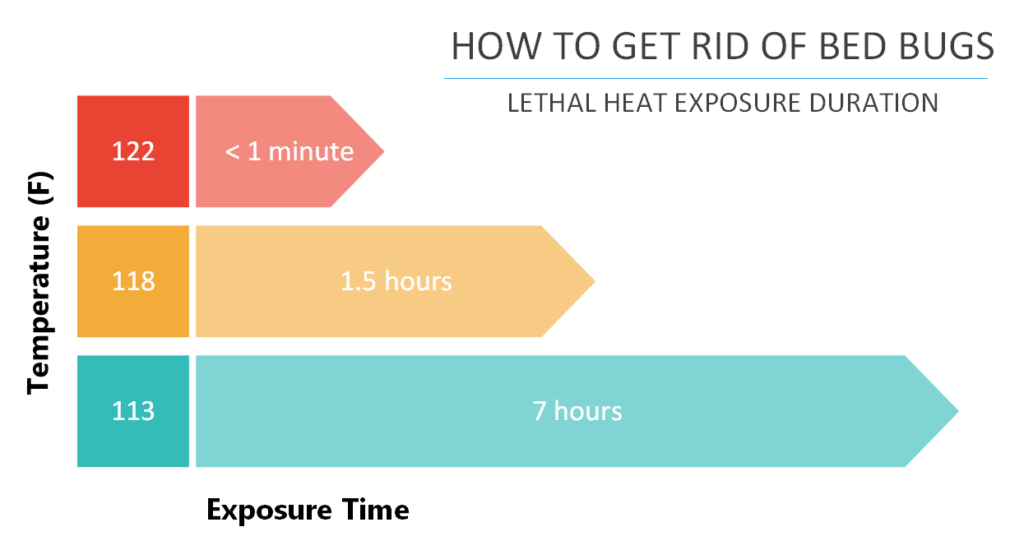
This table shows the length of exposure at various temperatures to kill bed bugs. These temperatures reflect bed bug core body temperature, not necessarily ambient temperature.
Another great advantage to heat treatments is that personal belongings can be left behind without fear of any chemical residue. After successful heat treatment, following up with a quarterly chemical maintenance treatment for long-term control is recommended.
Localized Heat Treatments & Steam Machines
In my experience with localized heat treatments, the use of steam machines tends to scatter bed bugs too much. We have found that heat treatments work best as an encapsulated treatment. When various items need to be treated for bed bugs, encasements should be used rather than a heat stream within a room.
My Experience With Heat Treatments
One of the most memorable bed bug cases I have encountered was in 2013. An elderly woman who lived alone in Washington state had been living with an extensive bed bug infestation for years when I was first called. I was not prepared for what I encountered. Bed bugs are not normally seen; they come out at night and hide during the day. However, the infestation in this home was so extensive that tens of thousands of bed bugs could be seen crawling around in broad daylight.
This woman was the only source of food for all of them, so you can imagine the discomfort she had endured for years. Behind every picture frame on the wall was a colony of at least 30-bed bugs; hundreds were within the crevices of her mechanical bed. Our crew, in full hazmat suits, tackled this home by extracting as many bed bugs as possible with ShopVacs and applying chemical treatments with Temprid (our ‘go to’ treatment at the time). Due to the extent of the infestation, the treatments hardly made a dent.
Having recently heard about heat treatments being promising for extensive infestations, I decided to invest in thermal equipment. Heat treatments were relatively new at that time, but I decided if ever there was an opportunity to put it to the test, this was it. This would be the first heat treatment used for bed bugs within the region at the time.
With heaters and fans, we brought the house temperature to 150 degrees for approximately 8 hours to ensure the heat saturated the home. The results were astounding. By the end of the treatment, several inches of carpet around the perimeter of interior rooms were nearly black, littered with dead bed bugs. The infestation within the home was completely eradicated in a single day. This marked the beginning of my extensive use of heat treatments for severe bed bug infestations in the years that followed.
In this particular case, and in most cases where the infestation was extensive, I followed up with monthly applications of Temprid as a maintenance treatment. This was very effective in preventing a reemergence within the home.
Four-Step Do-It-Yourself Guide
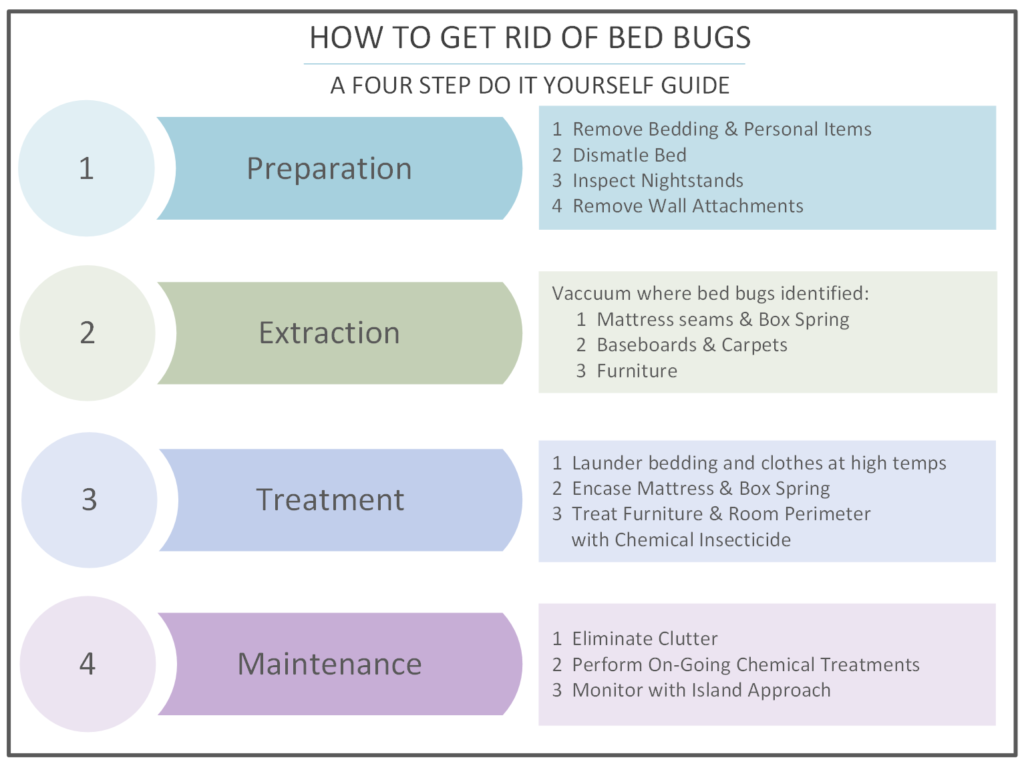
Bed bug infestations can get out of control quickly, so the key is treating outbreaks early. By taking early action and regular preventative measures, localized bed bug problems can often be handled without enlisting the help of a professional. For extensive infestations, I recommend contacting a licensed professional to evaluate whole-house fumigation or heat treatments. If you choose the DIY approach, there are four steps for effective and long-lasting elimination of bed bugs:
- Preparation
- Extraction
- Treatment
- Maintenance
While bed bugs have been known to travel up to 100 feet for a blood meal, the majority of them will inhabit areas within 6 feet of your bed. Keeping this in mind, the four-step DIY approach should focus on the following:
- Mattress (creases and seams)
- Box spring (underside)
- Furniture upholstery
- Baseboards
- Bedframe and headboard (especially near fasteners and corners)
- Wall attachments (especially on the wall behind the headboard)
- Carpets (especially near baseboards, under the bed, and where in direct contact with the bed)
- Window frames
- Closets
- Other small cracks and crevices
Preparation

Effective bed bug treatment begins with a few basic preparations.
Remove Bedding & Personal Items
Begin by removing all bedding, including sheets, mattress covers, blankets, and pillows. Place bedding in a sealed plastic bag until it can be laundered.
All personal items within 6 feet of the bed should be removed and sealed in plastic bags. This includes fabric items (clothes, curtains, shoes, stuffed animals), books, and electronics (computers, alarm clocks, radios).
Dismantle Bed
Next, disassemble the entire bed to expose areas where bed bugs are known to accumulate. This includes the underside of the box springs, the connections within the bedframe, and the backside of the headboard.
Inspect Nightstands
Due to the close proximity to the bed, nightstands are often a safe haven for bed bugs. Nightstands should be cleared of personal items, and drawers removed. Inspect the interframework of the nightstand, the backside, and the underside. You will revisit the nightstand during the extraction and treatment phase if any bed bugs are identified.
Remove Wall Attachments
Finally, anything attached to the wall (especially on the wall shared with the headboard) should be removed. In addition to pictures and mirrors, electrical outlets and switch plates should also be removed from the wall.
Extraction

Before treating any space for bed bugs, it is best to extract as many of them as possible physically. Vacuuming (typically with a ShopVac) is the best means of extraction. I recommend using pantyhose as a filter in the ShopVac to capture and eliminate bed bugs from the vacuum when finished.
During this process, any bed bugs that can be seen with the naked eye should be vacuumed. Again, focus on the dismantled bed, seams of the mattress, and box spring, and remove wall hangings, furniture, carpets, baseboards, and other areas within 6 feet of the bed.
Treatment

You are ready to treat the area once you have prepared the room and physically extracted as many bed bugs as possible from the infested space.
Bedding & Personal Items
Because heat is an effective treatment for bed bugs, washing and drying all bedding at high temperatures (>120 degrees F) is recommended.
Fabric items in bedrooms, such as curtains, stuffed animals, clothing, and shoes, are also susceptible to harboring bed bugs and should be laundered at high temperatures in the same manner as bedding. However, if washing is not feasible, simply toss in the dryer at >120 degrees F for ~30 minutes.
Electronics, books, and other non-washable personal items used near beds should also be treated. The best way to treat these items is to seal them in a plastic bag with Nuvan Prostrips for ~2 weeks. (With Nuvan Prostrips and other chemical treatments, it is important to refer to the product label and carefully follow the instructions provided by the manufacturer.)
Mattress & Box Spring
Treating your dismantled bed will be extremely important. Spray the bedframe completely using a commercially available chemical treatment (such as Temprid FX or Crossfire).
The underside of the box spring may be treated lightly with the same pesticide, but chemical treatments are not recommended for the mattress itself. After physical extraction via vacuuming, it is recommended that both the box spring and mattress be permanently encased in special bed bug covers (such as SafeRest Micro-Zipper encasements). These encasements trap any bed bugs that may have escaped physical extraction within the case, preventing them from escaping and feeding.
Note: If the infestation of the mattress is extensive, replacing the mattress and box spring may be warranted.
Furniture & Room Perimeter
After bedding, personal items, and the bed itself have been treated, move on to the treatment of the room perimeter and any furniture where bed bugs have been identified (e.g., nightstands). Depending on the size of the area to be treated, either an aerosol (Bedlam Plus) or spray (Temprid FX) is recommended.
Aerosol should be used for cracks, crevices, seams, and joints, while the spray is more appropriate for larger, exposed areas such as the baseboards. I recommend dusting wall voids (e.g., behind electrical outlets and switch plates) with a desiccant (CimeXa).
Maintenance

Eliminate Clutter
Reducing clutter in the vicinity of the bed minimizes the areas available for bug bugs to hide and makes treatment more effective. It also increases the chance that future bed bugs will be observed sooner, thus preventing larger infestations.
Perform On-Going Treatments
Following treatment for a bed bug infestation, ongoing maintenance treatments should be performed. After initial treatment, follow up with additional chemical treatments (Temprid FX) every four weeks for as long as there is evidence of active bed bugs. When no further evidence of active bed bugs exists, I recommend moving to quarterly preventative treatments.
Monitor With Island Approach
After a bed bug infestation, monitoring for future bed bugs is important. One common approach is often referred to as the Island Approach. To employ the Island Approach, the room should be set up so that the bed is only in contact with the floor, not touching the wall or furniture. All points of contact with the floor (bed legs or posts) should rest on a small platform designed to trap bed bugs that attempt to make their way to your bed for feeding. These special devices are often referred to as bed bug interceptors (SenSci Volcano).
Recommended DIY Products
While the list of commercially available products for DIY bed bug treatment is large, there are a few products that I have become very familiar with and continue to receive high reviews from colleagues in the industry. These include Crossfire, Temprid FX, and Bedlam Plus. All of these products combine pyrethrin and neonicotinoid to create a dual-action, synergistic insecticide that can also be effective against pyrethrin-resistant strains of bed bugs.
In addition to these chemical insecticides, Nuvan Prostrips, CimeXa (dust), SafeRest encasements, and SenSci Volcano bed bug detectors are often part of a comprehensive DIY strategy.
As with all products, it is important to carefully read and follow product labels for specific instructions on handling and applying safely and effectively.
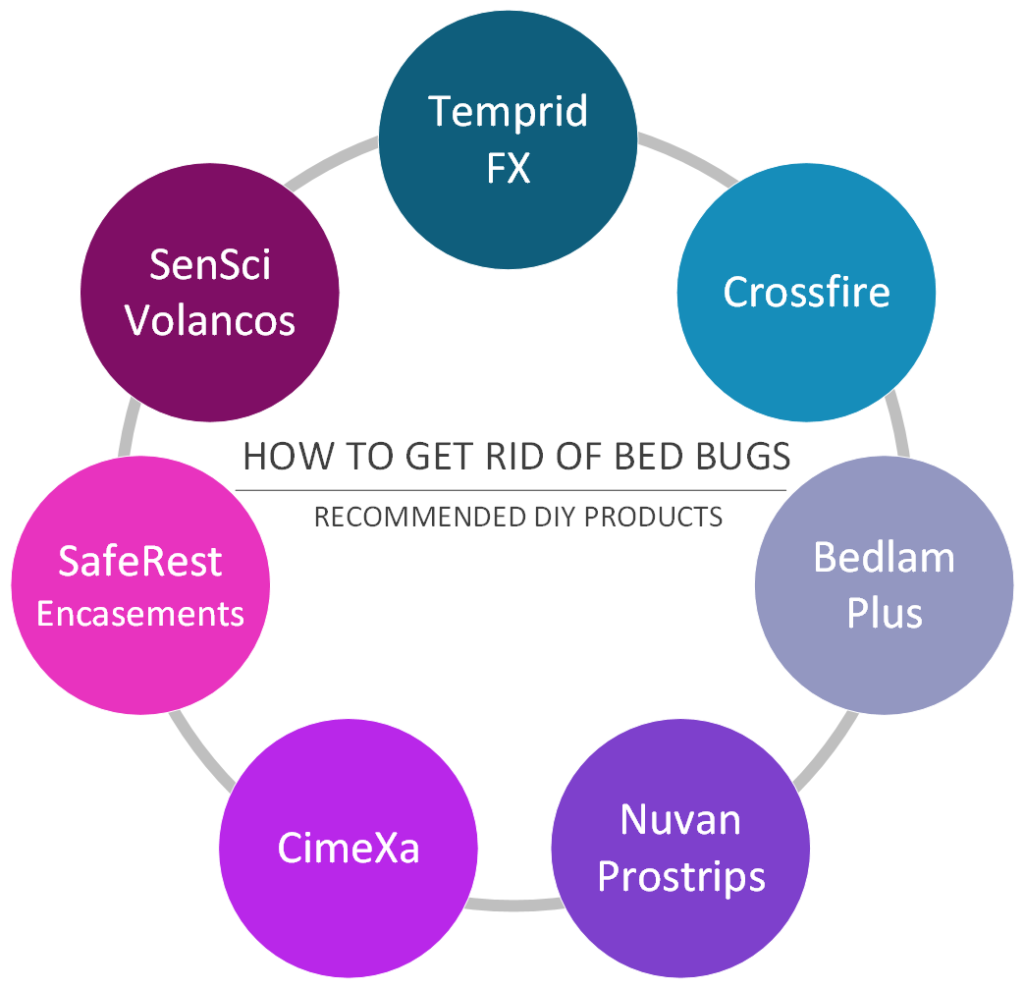
Temprid
Temprid (specifically Temprid FX) has been my preference for many years when it comes to chemical insecticides for treating and preventing bed bugs. Temprid is effective against bed bugs in all stages of life, including eggs, and can provide long-lasting residual protection. Both professionals and homeowners have successfully used it for years. It is applied via a spray pump and directly to furniture, upholstery, and carpet with minimal residue.
Active ingredients: Cyfluthrin (pyrethroid) + Imidacloprid (neonicotinoid).
Crossfire
Crossfire is an insecticide specifically formulated for the treatment of bed bugs. It is very effective against many pyrethroid-resistant strains of bed bugs at all stages of their life cycle. It kills bed bugs within minutes of exposure and has a long-lasting residual effect.
Active ingredients: Metofluthrin (pyrethroid) + Clothianidin (neonicotinoid) + PBO (synergist).
Bedlam Plus
Bedlam Plus is a very popular insecticide (in aerosol form), used for spot treatments of bed bugs. This product is often used in combination with other treatments. The aerosol application is great for cracks and crevices that can be difficult to reach with other treatments. Bedlam Plus is also a great treatment for personal items, such as suitcases, that need to be treated following travel.
Active ingredients: Phenothrin (pyrethroid) + Imidacloprid (neonicotinoid) + MGK-264 (synergist).
NOTE: Bedlam vs. Bedlam Plus: The latter product incorporates a neonicotinoid along with a pyrethroid for addressing pyrethroid-resistant bed bug strains. For the treatment of bed bugs, the Bedlam Plus is needed.
Nuvan Prostrips
Nuvan Prostrips are fumigation-type strips I recommend to treat household items that cannot be washed (e.g., electronics, books, shoes). These items can be enclosed within a plastic bag or encasement with a strip for about two weeks, over which time a chemical vapor is released and kills bed bugs hiding within the items. When using Nuvan Prostrips, it is important to read and follow manufacturer instructions carefully.
CimeXa
CimeXa is a common desiccant (dust) made of amorphous silica gel. This product is recommended for DIY bed bug treatments in conjunction with the previously mentioned DIY chemical insecticides. Lightly dust CimeXa beneath baseboards and behind electrical outlets and switch plates. Once applied, CimeXa is effective for several years if left undisrupted.
SafeRest Encasements
SafeRest products are highly recommended for encasing mattresses, box springs, and pillow covers. These encasements prevent bed bugs left behind after treatment from escaping, as well as prevent external bed bugs from finding safe haven in your bed.
SenSci Volcanos
SenSci Volcano Bed Bug Detectors are extremely useful devices for monitoring bed bugs. These are placed beneath bed posts to trap bed bugs as they climb up to feast. These are passive bed bug detectors, meaning they contain no active lure. The release of CO2 by humans in bed is the lure; these devices only capture them on their way.
Final Thoughts
As the old saying goes, “Sleep tight, don’t let the bed bugs bite,”… but sometimes it is inevitable. It is important to take swift action at the first signs of bed bugs to control the infestation. Without effective treatment, bed bug infestations will grow rapidly and spread to adjoining rooms. If addressed early and thoroughly, a localized outbreak can be treated with a Do It Yourself approach using some of the DIY products I have recommended. For more extensive and whole-house outbreaks, a pest management professional is recommended to evaluate and discuss heat treatment, fumigation, or other treatment options.